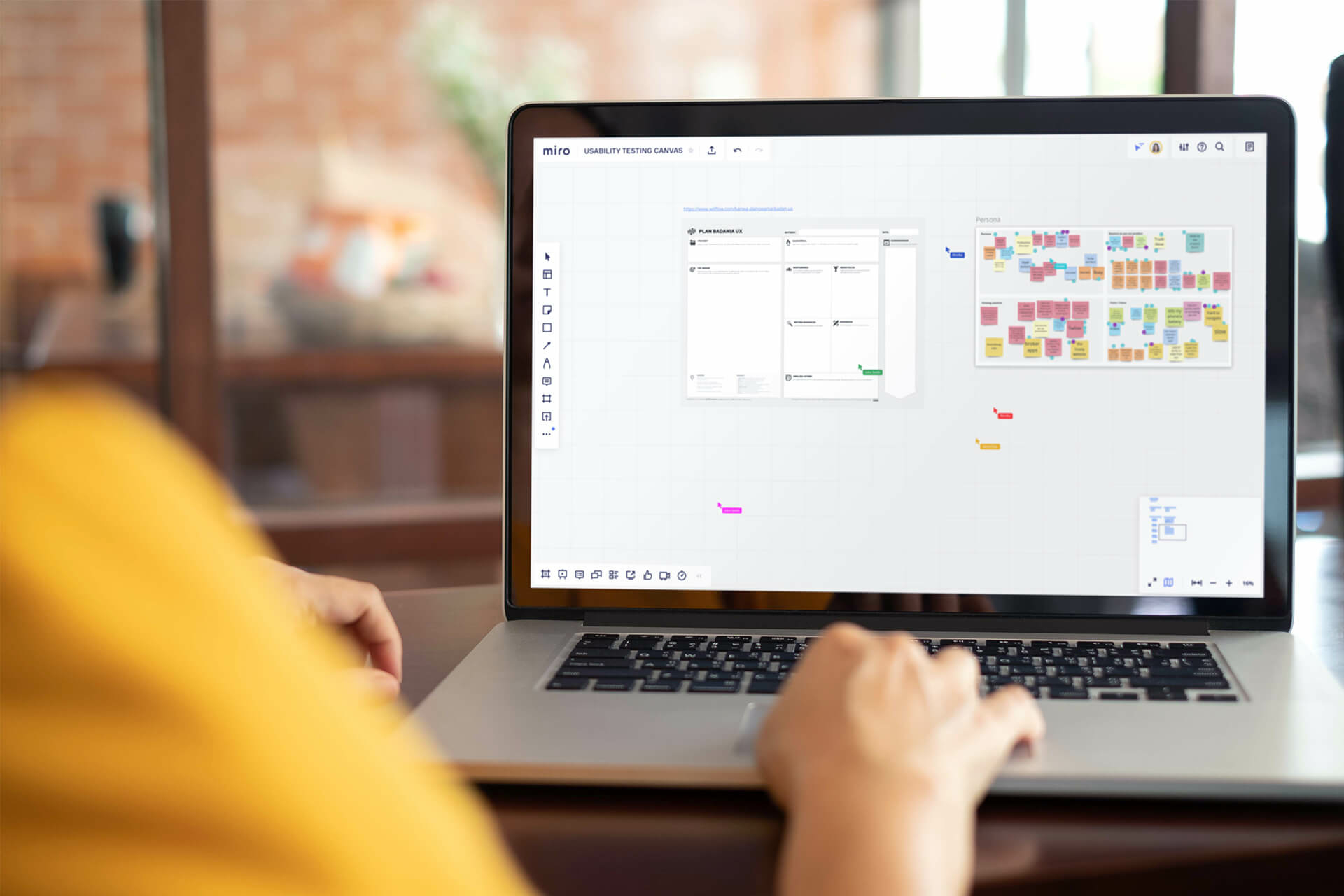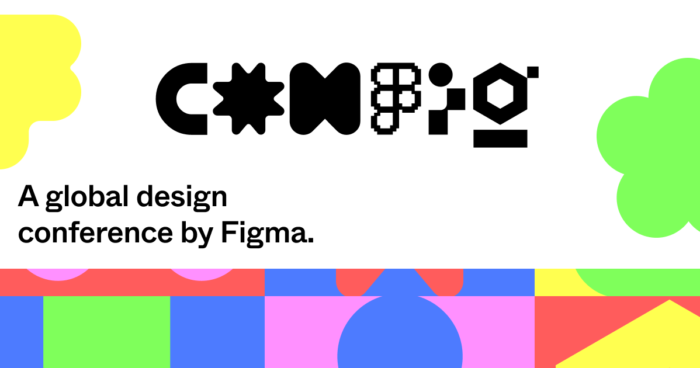Digital whiteboarding apps, like FigJam and Miro, make our life as designers, UX researchers, and strategists much easier, as they help remote teams ideate and collaborate online. Their market is growing fast due to the rising demand for digital spaces that facilitate teamwork. With the recent launch of FigJam, there has been much debate on whether this tool will stand a chance to compete with Miro, the industry giant. Let’s find out if it can.
Figjam vs Miro – the origins
Before we dive into the differences between Miro and FigJam, let’s take a quick look at how both products started their innovative journeys.
FigJam is the offspring of Figma – the world’s most popular software for app UI design. Let me share some statistics. Since being released in 2015, Figma has amassed over 4 million users. Its customers include many of the tech industry’s biggest players, such as Twitter, Slack, and Dropbox. According to Apptopia, Figma has 82,377 app downloads per month, and its customer base is steadily increasing.
Why did Figma decide to create FigJam? Considering its growing user base and the prevailing trend of remote work, Figma noticed that users needed to have a virtual place for efficient collaboration for things like brainstorming, mind mapping or workshops. So, the company decided to extend itself through a digital whiteboard. During its virtual design conference Config in 2021, Figma officially announced the launch of FigJam, which sparked intense debates on whether it could replace Miro.
Miro platform is a whiteboarding industry giant, with over 35 million users and nearly all of the Fortune 100 companies as clients. Since its launch in 2011, the product has grown enormously – with worldwide offices in Tokyo, Berlin, Paris, and New York.
Miro’s story began 10 years earlier than FigJam’s. The Founder, Andrey Khusid, noticed the need for his design agency to communicate ideas to clients who were located miles away from his office. The first digital whiteboard he created was called RealtimeBoard. As it grew more and more popular, it was rebranded and became the powerful visual collaboration platform we now know as Miro.
FigJam vs Miro – competing factors
Both Miro and FigJam are powerful tools for all things that aren’t hi-fi prototyping, like ideating, brainstorming, sharing, and discovering your ideas together with your team. They pack tons of features that make working remotely productive, engaging, and fun.
The most important include sticky notes with pre-built connectors, drawing tools, timers, voting stamps, audio conversations, and ready-to-use templates. All those features make them great tools for research, ideation, and workshops with clients.
But even though they have many shared functionalities, Miro and FigJam have some competing factors that differentiate one from another.
1. FigJam vs Miro – Usability
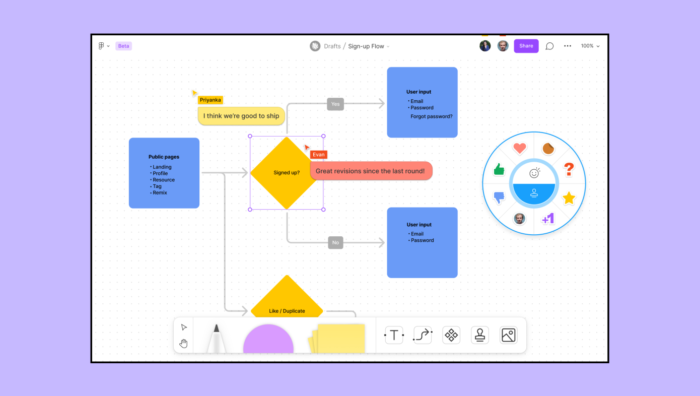
Miro is richer in functionalities because it’s an older product than FigJam. And more functionalities entail a more complex interface. Still, Miro does quite a good job in this aspect by highlighting the most important functionalities and hiding the less frequently used options. The whiteboard does not look cluttered.
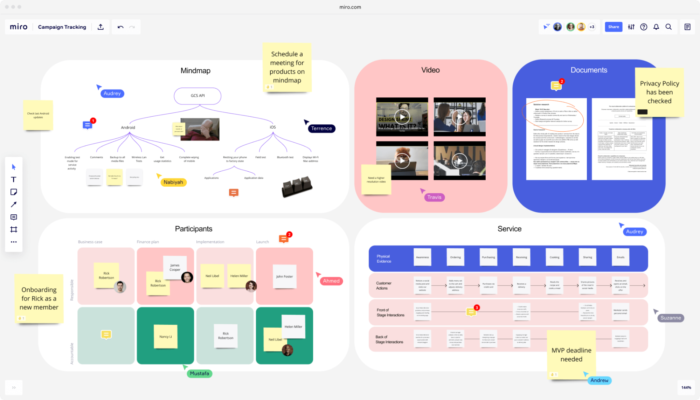
Miro may, however, be a bit overwhelming at first use, especially for less tech-savvy users. Due to different controls, some people may spend more time trying to figure out how to use it than actually collaborating. That’s why with Miro, we always start our product design workshops with clients by showing a quick tutorial. We show them how to use sticky notes, add text, vote for ideas, and what to do in case they get lost on the board.
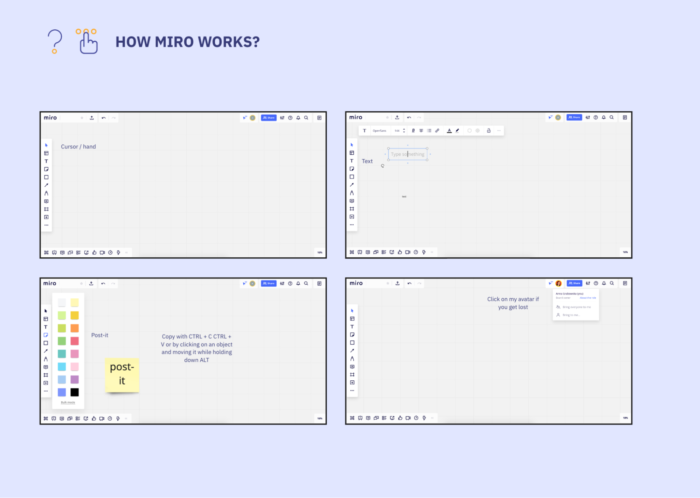
FigJam, in contrast, looks a bit like Miro’s MVP counterpart. It’s as if Miro was stripped down to the absolute core functionalities, but in a good way! The whole interface is extremely simple, yet powerful. The bottom toolbar integrates skeuomorphic elements (pen tool and sticky notes look like real-life objects) to make it even easier for users to reach for things they need. A clear visual hierarchy allows users to seamlessly navigate the board.
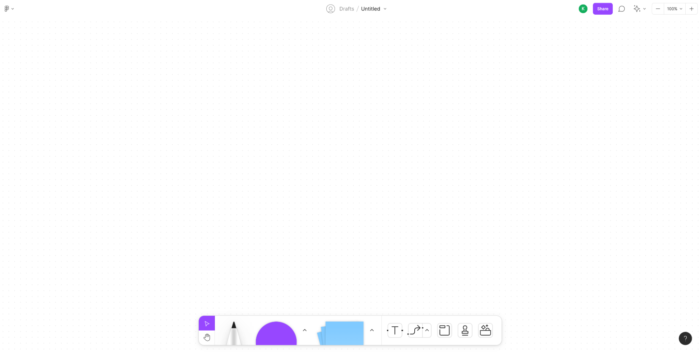
FigJam is much simpler than Miro. The fact that it has fewer functionalities is actually an advantage. The panel at the bottom is super helpful because I can see what I can use and have everything I need at hand.
Olga Dziennik Miquido workshop participant
FigJam is much simpler than Miro. The fact that it has fewer functionalities is actually an advantage. The panel at the bottom is super helpful because I can see what I can use and have everything I need at hand.
Olga Dziennik
Miquido workshop participant
In general, FigJam is easier to use than Miro. Even our non-tech clients enjoyed using the tool during workshops. They immediately understood how to apply the tools they needed and were amazed by the number of engaging features, like emoticons, stamps, or live chat cursors.
2. Miro vs Figjam – Pricing
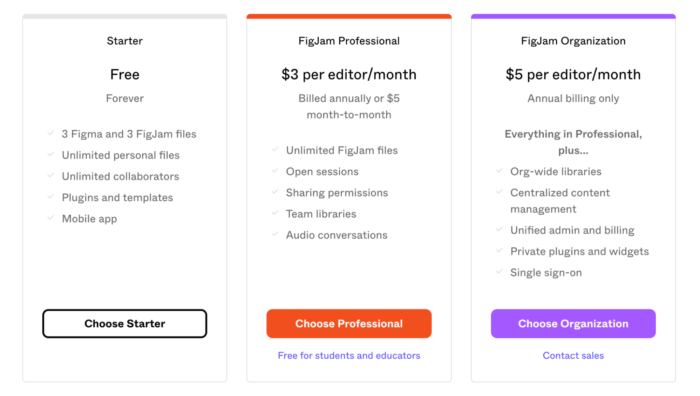
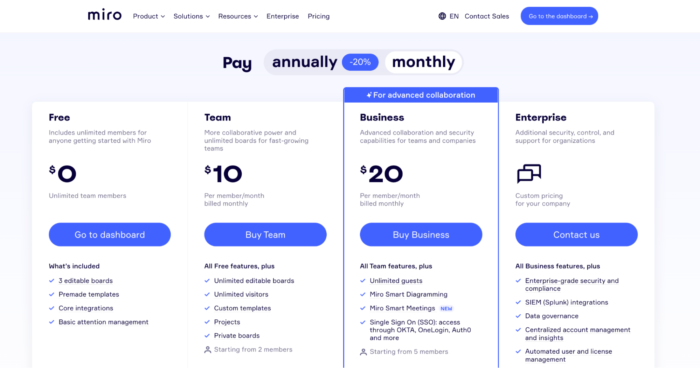
The numbers speak for themselves. When it comes to team and organization plans, FigJam wins in the pricing race. FigJam is over 3 times cheaper than Miro on the team plan and 4 times cheaper on the organization plan.
As an additional benefit, FigJam has something called true-ups. When you work with many clients, every now and then it happens that someone on the client’s side requests editing permissions. Both apps charge a certain amount of money based on the number of such editors.
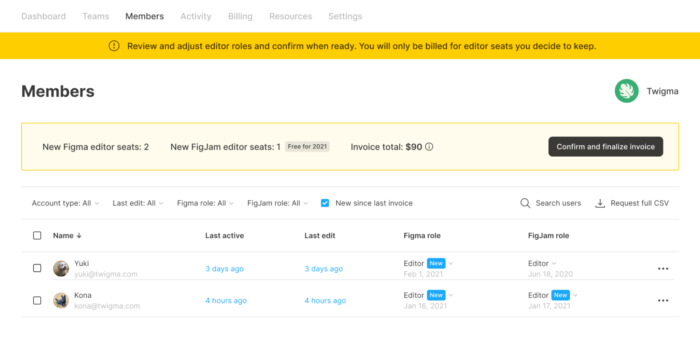
What FigJam does in true-ups is that if you have an organization or enterprise plan, it allows you to review admins and confirm new editors. How does it work?
Every three months, FigJam sends a summary of new editors and notifies you 2 weeks before the due payment. As a result, you are charged only for the total number of editor seats. You choose who can stay an editor and, consequently, reduce the number of additional costs.
3. Miro vs Figjam – templates
One of the key advantages of Figma is that it’s community-based. This means that users themselves can be a part of the product by sharing various templates, design systems, and plugins.
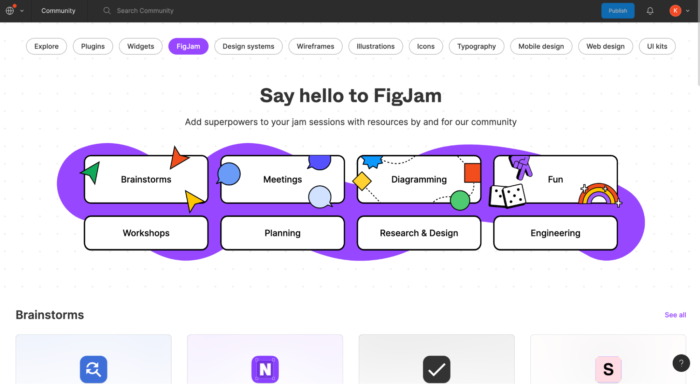
In FigJam Community, users can browse through templates for:
- Brainstorming and workshops – to run product discovery and ideation with empathy maps, information architecture diagrams, user journey maps, flow charts, and many more
- Meetings – to optimize agendas, create to-do lists, conduct daily stand-ups, track goals, or plan project schedules
- Fun – to integrate team members with ice-breakers, gifs, or games like chess or rock paper scissors
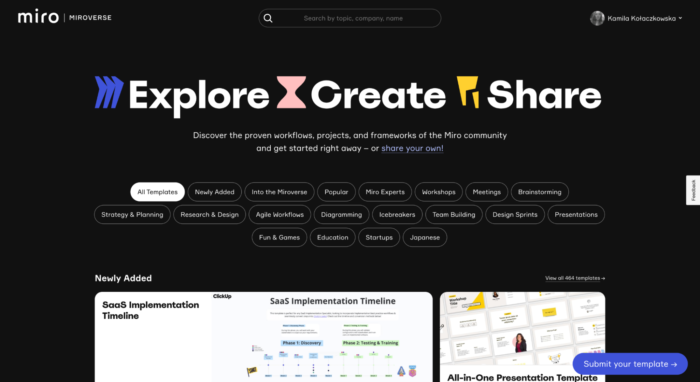
Miro’s counterpart to FigJam’s Community is Miroverse. It has similar templates as all the mentioned above and much more. The advantage of Miro is that its library of templates is much richer and wider in variety. It also has templates for more advanced information structures, drawing up large-scale plans or schemes.
Thousands of pre-made templates are neatly organized into categories, like Brainstorming, Workshops, Research & Design, Design Sprints, or Startups. What’s more, users can filter them by choosing the most recently added, most popular, or curated by experts.
Another advantage of Miro is that some templates, e.g. user stories, can be modified by pressing keyboard shortcuts – users can simply press enter to add another column to the table. FigJam’s templates are built out of components that can’t be so quickly modified.
4. FigJam vs Miro – design workflow
One competitive advantage of FigJam is that it’s automatically integrated with your libraries on Figma. Whenever you build a design system, you publish libraries with components – re-usable interface elements, like buttons, inputs, toasts, pop-ups, and so on. FigJam allows you to use those components on its whiteboard to make it easier for design teams to build screens and illustrate their ideas.
When you open a library in FigJam, it initially floats above your board and disappears once you’ve dragged an object to your board. But if you want, you can also pin the component library to the board and always have the building blocks at hand.
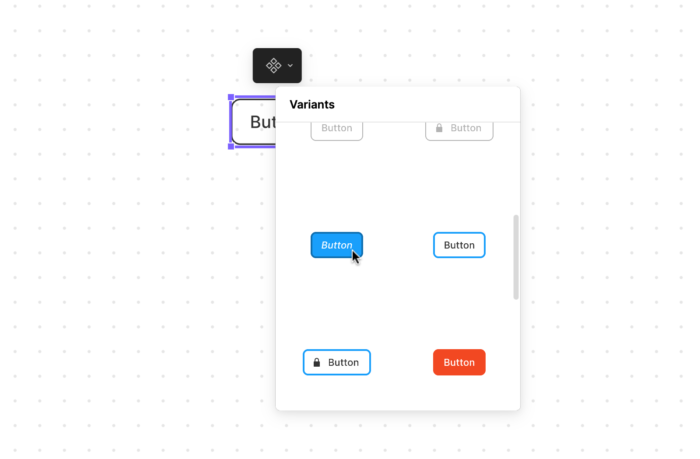
Another cool thing about FigJam is that you can keep all your workshop, research, and UI files in one place. Exporting projects from Miro used to be really irritating. Not only did you have to search for the export functionality, but sometimes you also had to unlock certain boards and make them smaller to actually be able to export them.
From FigJam, you can easily copy user flows and other ideas that originated during workshops to other files on Figma. Additionally, any comments that were added by clients, developers, and digital product design team members won’t get lost during the export.
FigJam vs Miro – summary
Both Miro and FigJam are incredible tools for remote collaboration, sharing, and brainstorming ideas with your team.
But when it comes to usability, our workshop experience shows that clients enjoy and understand FigJam better than Miro. Not only does it have a cleaner and simpler interface, but it also has an abundance of entertainment features, like emoticons, voting stamps, and live cursor chat.
Clients also liked the bottom toolbar, which made it easy for them to reach for the things they needed. Miro’s interface, in contrast, was a bit overwhelming for some people who needed a bit more time to get familiar with the tool.
FigJam also wins the competition in pricing. It’s almost 3 times cheaper on the team plan and 4 times cheaper on the organization plan than Miro. Its pricing policy is also more transparent thanks to billing true-ups. They allow you to manage the number of editors and, consequently, get rid of additional costs.
Miro has turned out to be the platform with a greater variety of premade templates. As a product that has been longer on the market, it has created a truly inspiring library of various templates that can be effectively used for workshops with clients, internal team discussions, or brainstorming product ideas. With such a variety, Miroverse templates allow structuring diagrams and plans of any complexity. But although FigJam is 10 years younger than Miro, it’s still hot on Miro’s heels. Because it’s community-based, we can count on many new templates to be created or even promote our own.
FigJam allows you to store all your research, workshop, and UI materials in one place, without having to export anything. FigJam works with Figma, so components or other design objects created on FigJam can easily be moved to Figma. Exporting from Miro used to be quite annoying, but now it’s enough to just copy and paste — and you won’t lose any comments in the process. All ideas and suggestions from clients, developers, product owners, and product design team members will be preserved inside FigJam.

